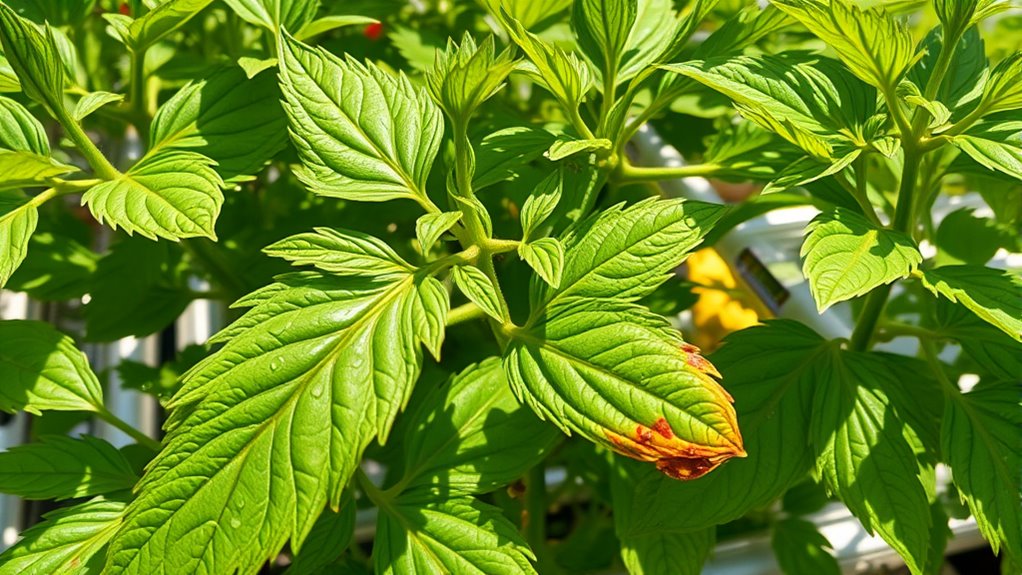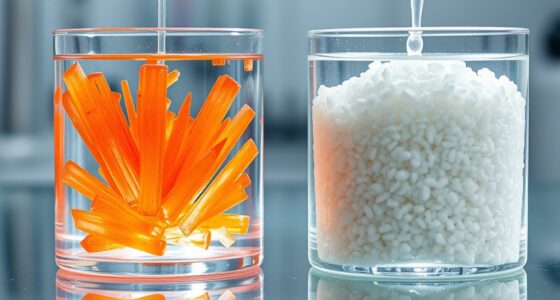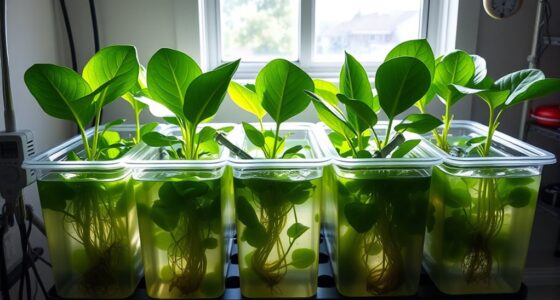During summer hydroponics, nutrient burn shows as yellow or brown leaf tips and edges, often from over-fertilizing, while deficiencies reveal yellowing, stunted growth, or poor development. To troubleshoot, check your nutrient levels and adjust carefully; avoid adding too much at once. Maintain proper pH and oxygen levels, and make certain temperature stability. If you want to identify subtle signs and prevent crop issues, there’s more to take into account to keep your plants healthy.
Key Takeaways
- Nutrient burn appears as yellow or brown leaf tips, often from over-fertilization, while deficiencies cause uniform yellowing or stunted growth.
- Check the color and pattern of leaf damage to distinguish between toxicity (burn) and deficiency symptoms.
- Test nutrient solution levels regularly to ensure proper concentration and avoid overfeeding or underfeeding.
- Observe plant growth; deficiencies typically cause slow development, whereas burn damages leaf edges first.
- Adjust nutrient levels carefully based on symptoms, ensuring balanced feeding and avoiding excess salts or lack of essential nutrients.

Summer hydroponics can present unique nutrient challenges that, if not managed properly, can hinder plant growth. During the hotter months, your nutrient solution can become unstable, leading to issues like pH imbalance and root rot, both of which threaten your plants’ health. One common problem is pH imbalance, which occurs when the pH level of your nutrient solution drifts outside the ideal range—usually between 5.5 and 6.5 for most crops. When this happens, plants can’t absorb nutrients properly, causing deficiencies or toxicities. If you notice yellowing leaves or stunted growth, check your pH levels immediately. Adjusting the pH with pH up or down solutions can restore the balance, guaranteeing your plants can absorb nutrients efficiently. Maintaining a stable environment and monitoring nutrient levels regularly is essential for healthy plant development.
During summer, monitor pH levels closely to prevent nutrient deficiencies and support healthy plant growth.
Root rot is another serious concern, especially when the root zone stays overly wet or becomes contaminated. Excessive heat can accelerate bacterial growth, and if your system isn’t properly aerated, it creates an environment ripe for root rot. This condition causes roots to decay, cutting off water and nutrient uptake, and can quickly kill your plants. To prevent root rot, maintain good oxygen levels in your hydroponic system by ensuring proper aeration and avoiding overwatering. Regularly inspect roots for signs of browning or sliminess, which indicate rot. If detected early, removing affected roots and improving aeration can save your plants. It’s also essential to keep your nutrient solution at the correct pH, as imbalanced pH levels can weaken roots and make them more susceptible to rot and disease.
Temperature fluctuations during summer can exacerbate nutrient issues. High temperatures increase evaporation rates, concentrating nutrients and causing pH swings. This fluctuation can lead to nutrient lockout, where plants are unable to access essential elements, resulting in deficiencies that mimic over-fertilization symptoms. Conversely, overcompensating with extra nutrients during these times can cause nutrient burn, damaging leaves and roots. To prevent these problems, monitor your system’s temperature and nutrient levels daily. Using cooling systems, shade, or fans can help stabilize conditions, avoiding both pH imbalance and root rot. When adjusting nutrient concentrations, always dilute carefully and test frequently to prevent toxicity.
In essence, managing summer hydroponics requires vigilance. Keep a close eye on pH levels, guarantee your system is well-aerated, and regulate temperature and humidity to mitigate these common issues. By proactively maintaining balanced conditions, you’ll support healthy root systems and prevent problems like pH imbalance and root rot from sabotaging your crop yields. Consistent monitoring and prompt adjustments are your best tools to keep your hydroponic garden thriving during the heat of summer. Proper nutrient stability is crucial for consistent plant health and growth, especially during extreme weather conditions.
Frequently Asked Questions
How Can I Prevent Nutrient Issues During Unexpected Heatwaves?
During unexpected heatwaves, you can prevent nutrient issues by monitoring plant stress levels and adjusting your nutrient balance accordingly. Keep an eye on water temperature and guarantee proper aeration to avoid root stress. Dilute nutrients if necessary, and provide shade if plants show signs of heat stress. Consistent checks help you maintain ideal nutrient levels, reducing the risk of nutrient burn or deficiencies during extreme weather conditions.
What Are the Signs of Overwatering Affecting Nutrient Uptake?
Ever wonder if overwatering is silently harming your plants? When it happens, root rot and oxygen deprivation set in, choking nutrient uptake. You might notice wilting leaves despite moist soil, or slow growth that defies your efforts. The danger lies in the roots’ inability to breathe, causing nutrients to stagnate. Stay alert—healthy roots mean healthy plants, and preventing overwatering keeps your hydroponic system thriving.
Can Different Plant Species Have Varying Nutrient Burn Symptoms?
You might notice that different plant species show varying nutrient burn symptoms because of species variation. Some plants may develop browning or scorching at leaf edges, while others show more generalized leaf damage. This symptom diversity occurs because each species absorbs and processes nutrients differently, making it essential to recognize these differences when diagnosing issues. By understanding species variation, you can better tailor your hydroponic nutrient management to prevent burn and promote healthy growth.
How Does Ph Fluctuation Influence Nutrient Deficiencies?
Imagine your nutrient solution as a river, where pH stability is the riverbank, guiding water flow. When pH fluctuates, it’s like the river breaking its banks, causing nutrient solubility to fluctuate. This disrupts nutrient uptake, leading to deficiencies. Maintaining steady pH guarantees nutrients stay dissolved and available, preventing deficiencies. Consistent pH stability keeps your plants thriving, just as a steady river sustains its surrounding life.
What Are Eco-Friendly Solutions for Nutrient Correction?
When correcting nutrient issues, opt for eco-friendly solutions like organic amendments and compost teas. These natural options help restore nutrient balance without harming your environment. You can add compost teas directly to your hydroponic system for quick absorption or use organic amendments to slowly improve nutrient levels. This approach promotes healthy plant growth while reducing chemical runoff, making your hydroponic setup more sustainable and eco-conscious.
Conclusion
As summer’s sun blazes overhead, remember that balancing nutrients is like walking a tightrope over a shimmering pond—one misstep can lead to scorching burn or wilting deficiency. Keep a vigilant eye on your plants’ vibrant leaves and stubborn yellowing, adjusting your approach like a skilled conductor guiding an orchestra. With patience and keen observation, you’ll navigate these nutrient waters smoothly, ensuring your hydroponic garden thrives in the warmth, bursting with lush, healthy growth beneath the summer sun.










